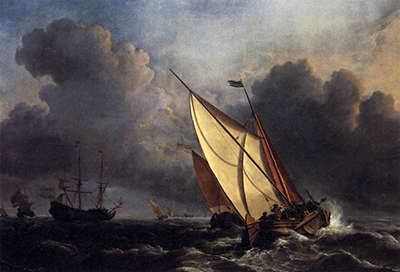Dutch Fishing Boats in a Storm is a 1801 romanticist painting from JMW Turner, now under the ownership of the National Gallery in the UK.
The position of the vessel found here is not quite as perilous as seen in a similar Turner painting, namely Dutch Boats in a Gale. This journey looks more uncomfortable and desperate, with the ship swaying to the left as it makes it way forwards as part of a large convoy of vessels. Its sail is bright and captures what small amount of light is used in the painting, reflecting it directly at the viewer. There are also touches of bright white on the sea as it flies upwards. The clouds above are dark and aggressive, whilst the sea below looks cold and unforgiving.
There are always additional vessels in the far distance within Turner's seascapes, so as to add interest and perspective. They appear to be in far more tranquil waters, but it may simply be that they are larger ships, and therefore better designed for handling conditions such as these. The angle of the ship may remind some of Breezing Up (A Fair Wind) by Winslow Homer as well as Raft of the Medusa by Thoedore Gerciault. Both of those scenes are also particularly famous within the realms of art history.
Turner was devoted to seascape art and produced many paintings in this genre across the full length of his career, with one of the most famous being Fishermen at Sea, which features a similarly dark use of lighting as found within his two Dutch boat paintings. The compositions of all three are decidely similar, in fact, with a single main vessel pictured centrally, engulfed in rocky waves, with several other smaller ships placed in the far distance. This is a classic style of depicting such scenes, but Turner's own use of light and colour was more expressive than seen in previous artists' work. Other notable romanicist artists also took on the seascape genre within their careers, such was its importance within this period in society.




